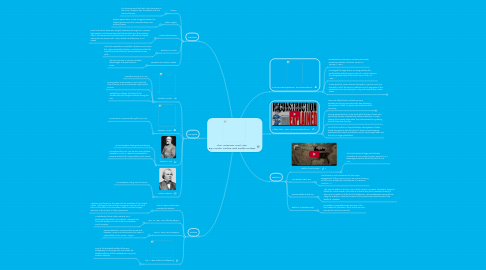
1. Causes
1.1. Slavery
1.1.1. The burning issue that led to the disruption of the union, however, was the debate over the future of slavery.
1.2. States' Rights
1.2.1. States’ Rights refers To the struggle between the federal government and individual states over political power.
1.3. Dred Scott Decision
1.3.1. Dred Scott was a slave who sought citizenship through the American legal system, and whose case eventually ended up in the Supreme Court. The famous Dred Scott Decision in 1857 denied his request stating that no person with African blood could become a U.S. citizen.
1.4. Election of Lincoln
1.4.1. When the Republican candidate Abraham Lincoln won the 1860 presidential election, Southern fears that the Republicans would abolish slavery reached a new peak.
1.5. Secession of Southern States
1.5.1. After the election of Lincoln, southern states began to break free from Union.
2. People
2.1. Abraham Lincoln
2.1.1. President during Civil War.
2.1.2. Emancipation Proclamation (1863)- declared that all slaves in the Confederate States would be free
2.1.3. Gettysburg Address -to honor all the soldiers who had fought and died during the war
2.2. Ulysses S. Grant
2.2.1. He served as a General during the Civil War.
2.3. Robert E. Lee
2.3.1. He had negative feelings toward slavery.
2.3.2. Throughout the Civil War, he won many battles, however on April 9, 1865 he surrendered to General Grant at the Appomattox Court House.
2.4. Andrew Johnson
2.4.1. Vice President, along side of Lincoln.
3. Dates
3.1. Nov 6, 1860: Lincoln wins presidential election.
3.1.1. Abraham Lincoln wins a four-way race for President of the United States. Although he does not win a popular majority and is not even on the ballot in nine southern states, he earns enough electoral votes to beat all other opponents.
3.2. April 12, 1861: War officially begins.
3.2.1. Confederate forces under General P.G.T. Beauregard bombard Major Robert Anderson and his Union soldiers at Fort Sumter in Charleston, South Carolina.
3.3. April 9, 1865: Lee Surrenders
3.3.1. General Robert E. Lee surrenders to General Ulysses S. Grant in a farmhouse in the town of Appomattox Court House, Virginia.
3.4. July 1, 1863: Battle of Gettysburg
3.4.1. One of the bloodiest battles of the war, Gettysburg is a turning point, and marks the farthest advance of the Confederate Army into northern territory.
4. The Emancipation Proclamation
4.1. presidential proclamation and executive order issued by President Abraham Lincoln on January 1, 1863.
4.2. it changed the legal status, as recognized by the United States federal government, of 3 million slaves in the designated areas of the South from "slave" to "free."
4.3. It was issued as a war measure during the American Civil War, directed to all of the areas in rebellion and all segments of the executive branch (including the Army and Navy) of the United States.
4.3.1. Included
4.3.2. Included
4.3.3. Excluded
5. After the War: Reconstruction
5.1. The most difficult task confronting many Southerners during Reconstruction was devising a new system of labor to replace the shattered world of slavery.
5.1.1. Materials
5.1.2. Personel
5.1.3. Services
5.1.4. Duration
5.2. During Reconstruction, many small white farmers, thrown into poverty by the war, entered into cotton production, a major change from prewar days when they concentrated on growing food for their own families.
5.3. Out of the conflicts on the plantations, new systems of labor slowly emerged to take the place of slavery. Sharecropping dominated the cotton and tobacco South, while wage labor was the rule on sugar plantations.
6. Battles
6.1. Battle of Fort Sumter
6.1.1. The bombardment/siege and ultimate surrender of Fort Sumter by Brig. General P.G.T. Beauregard was the official start of the Civil War
6.2. First Battle of Bull Run
6.2.1. Also known as First Manassas, the first major engagement of the American Civil War was a shocking rout of Union soldiers by confederates at Manassas Junction, VA.
6.3. Second Battle of Bull Run
6.3.1. The Second Battle of Bull Run, also called Second Manassas, resulted in a second defeat for Union troops in the area of First Bull Run (First Manassas), though it was not a complete rout like the first battle was. The Confederate victory set the stage for Robert E. Lee’s first invasion of the North, which would result in the Battle of Antietam
6.4. Battle of Waynesborough
6.4.1. The Battle of Waynesborough was one of the later battles of Sherman’s March to the Sea and opened the route to Savannah.
